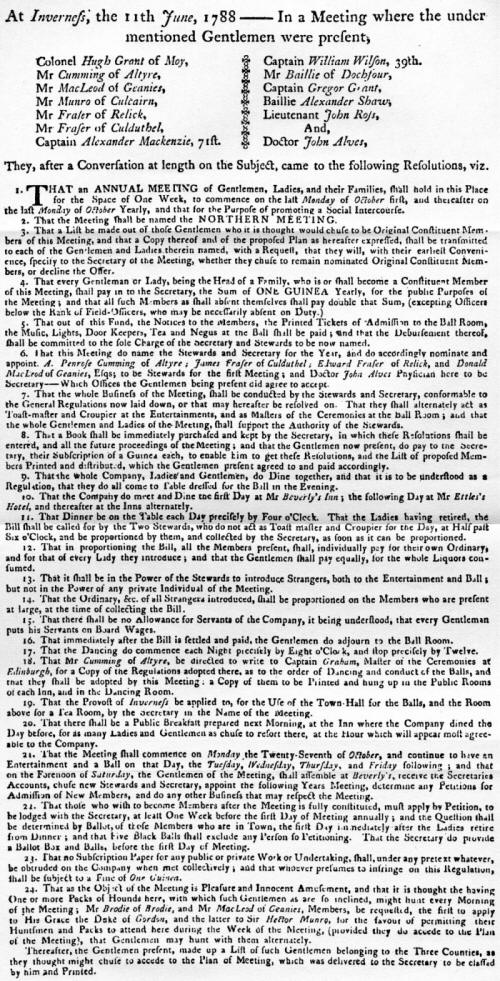|

IN 1788 the Northern
Meeting was instituted. On the 11th June that year a meeting was held at
which were present Colonel Hugh Grant of Moy, Messrs. Cumming of Altyre,
Macleod of Gramis, Munro of Culcairn, Fraser of Relick, Fraser of
Culduthel, Baillie of Dochfour, Captains Alex. Mackenzie, 71st Regiment,
William Wilson, 39th Regiment, Gregor Grant, Lieutenant John Rose, and Dr.
John Alves (appointed first secretary). They formed the Society for an
annual week of social intercourse, one guinea subscription for each head
of a family, and any absentee to be fined two guineas. In the first year
£40 came in from such fines, absence on duty being the sole excuse. The
first stewards were Messrs. Cumming, the Frasers of Culduthel and Relick,
and Macleod. No games were intended, only balls and dinners. The company
dined together in full evening-dress, alternately at the hotels of Messrs.
Beverley and Ettles, dancing from eight to twelve. Only stewards could
invite strangers. The regulations in force at Edinburgh were obtained from
Captain Graham, M.C., in that city. The town hall was the place of
dancing, with the room above, called the Guildry, for tea. A public
breakfast was provided. Anyone producing a subscription paper before a
full assembly was fined a guinea. The mornings seemed to require some
occupation, so Brodie of Brodie and Macleod were deputed to invite the
huntsmen and hounds of the Duke of Gordon and Sir Robert Munro of Foulis.
About ninety members joined from the counties of Inverness, Ross, Nairn
and Moray, and the date was the second week in October. Formal balls
becoming rather too heavy, they were reduced to two, with undress dances
and card parties to fill the gaps. The uniform worn, according to an old
authority, was a grass green coat with buff edging, white metal buttons,
black velvet cape with four silver embroidered or vellum buttonholes; buff
or fancy waistcoat, buff or black silk breeches, the buttons having N.M.
engraved thereon. Truly a gay cavalcade for the Highland Capital ! In 1810
the third week is selected, and by the desire of the Marquis of Huntly all
members had to appear in blue coats from the Inverness Woollen Factory to
stimulate local industry. The stewards now receive badges, then wands,
then tartan sashes, and last, badges again.
In 1816 a plate of fifty
guineas was given out of the funds for any horse carrying ten stone that
had never won a plate (Hunter's Plate excepted); a special committee was
appointed to provide the course at a cost of £20; but this did not
continue for long as part of the programme. The course was at Duneancroy,
but the tax on the funds being too much it was stopped. The present races
are quite independent.
Games proper began in 1840,
at first by private subscription, in the Academy Park, afterwards at the
Longman Park. In the early sixties the present park was bought from the
late Sir Alexander Matheson of Ardross and walled round. A pavilion,
followed by a second, was subsequently added. The annual assemblies
required their own room, so in Church Street ground was bought and
erections built gradually. In 1801 this building was greatly damaged by
fire. It was very near a candle factory, above which was a powder magazine
! It is perhaps unnecessary to observe how lax the regulations on these
matters must have been under good King George III !
Heat one day reached the
powder, with the natural consequences, seven lives being lost and many
persons injured. The factory itself was also damaged. The rooms had to be
rebuilt, and in 1845 or thereabouts assumed the form in which they are
to-day, but internally they have been greatly improved since that date.
Even in 1795 and subsequently the meeting continued, in spite of
Napoleonic Wars; in 1796 we read of a "brilliant assembly of beauty and
fashion."
Cholera prevents it in
1832, and the South African War in 1900, though in the latter year
Highland sports were held on one day. No fines are now inflicted on
absentees, and the terms of admission have often been changed. The uniform
is a thing of the past, but Highland dress takes its place, the meeting
being recognized as a prominent permanent festival and fashionable
institution. |

